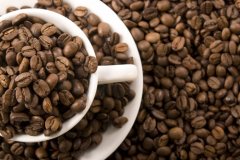Introduction of Rwanda boutique coffee taste flavor Rwanda coffee producing area
Rwanda is a landlocked country located in the southern equatorial part of central Africa, bordering Tanzania in the east, Burundi in the south, Congo (DRC) in the west and Uganda in the north. There are many mountains in the territory, and it is known as the "Country of Thousand Hills". The Congo and Nile divide runs through western Rwanda from north to south.

Rwanda's economy is primarily agricultural. 92 per cent of the population is engaged in farming. Cash crops mainly coffee, tea, cotton. Rwanda is still a backward country because it is an agricultural country and the genocide in 1994 caused the loss of many young workers. It was a huge blow to this already poor country. After the civil war, Rwanda has stepped up its development in coffee cultivation and trade. In recent years, the Rwandan government has also taken active measures to establish coffee production cooperatives in various places, giving technical guidance and financial support to farmers, hoping to drive domestic economic development to a certain extent through coffee industry. Because of the excellent performance of Rwandan coffee in recent years, it has become more and more famous in the international market.
Rwanda has been growing coffee since colonial times. Although coffee is the main crop, the quality of coffee produced in Rwanda is not outstanding. The status of coffee in the world is low and few people pay attention to it. Rwanda grows mostly bourbon coffee varieties. Rwanda, known as the "country of thousands of hills", has a high altitude mountain environment, fertile volcanic soil and abundant rainfall, which is conducive to the growth of coffee trees. The advantages of varieties combined with excellent natural conditions should have produced high-quality coffee, but why is the performance of coffee quality unsatisfactory? The reason lies in the later processing links. Improper processing will reduce the quality of coffee and sacrifice many good flavors in vain. Harvesting, planting, processing, grading, transportation and other links will directly affect the quality of coffee beans, in which the lack of control in a certain link will become a stumbling block to make good coffee.
Coffee fruits need to be transported to the processing plant as soon as possible after picking, but due to lack of facilities in the country, it is impossible to process the fruits in the first time. The fruits accumulate together after being picked, and lack of ventilation will continue to accelerate mold and rot. The rotten fruits will affect the quality of coffee and appear defective flavor.
Rwanda has made great progress in coffee production and processing in recent years. First of all, coffee fruits are picked manually; coffee production cooperatives are set up all over the country to provide technical guidance to coffee farmers; coffee farmers send coffee processing stations for cleaning and screening as soon as possible after picking, and select mature and high-quality coffee fruits for processing.
Rwandan coffee is mostly washed. The washing method first washes and floats the ripe coffee fruit, then removes the exocarp, pulp and part of the pectin layer, then sends the coffee to the fermentation tank, ferments the remaining pectin layer and sends it to the drying field for drying treatment, so that the moisture content reaches about 13%. The coffee in the above picture is placed on the African shed for drying to avoid the coffee contaminated with soil. The ventilation effect is better during drying to avoid mildew. Coffee farmers also regularly flip beans during drying to make drying more uniform, and at the same time select beans of poor quality to discard.
With the improvement and upgrading of Rwandan coffee in all aspects, its quality has also made a qualitative leap. Rwanda's Anomeca Premium Washed Bourbon defeated Jamaica Blue Mountain No. 1 and Sumatra Mandning G1 Special to retain the title in the 2008 COE Competition organized by SCAA. Rwandan coffee has won a place in the coffee world with its excellent quality and won more attention.
Rwanda beans, bourbon seeds, washed. The picture below shows ripe beans, light to medium baked, round and plump, beautiful beans.
When it comes to Rwanda's flavor, shame on the biased perception of Rwanda at first. I remember when I first came into contact with coffee, carrying out olfactory training was very resistant to No.3 in the 36-scent bottle, and even felt like vomiting when I smelled it. Therefore, subjectively, I always like to make up the taste of grass for the smell of green peas. Due to lack of experience in tasting and making, they will subjectively list Rwanda's grassy, lavender-like aroma as their own conflicting flavor. So when Rwanda is made and smells its characteristic lavender scent, the coffee bug retracts back into its stomach. However, with the improvement of tasting and production experience, there is a new understanding of Rwanda with its unique aroma.
Before sharing this article with you, in order to have a more objective evaluation of Rwanda, I have specially evaluated it by cup test. Well-roasted and washed Rwanda with nutty aromas of roasted peanuts, spice and wood. Wet lavender, grass aroma strong, temperature drops a little after the fruit-like sweetness increases, lavender flavor decreases. Clean and mellow taste, good aftertaste, lasting aroma. The acidity is softer and the overall feeling is full and stretched.
Rwanda is like a friend with a distinct personality in life. At first contact, he will stay away because of his too distinct personality, but after really understanding each other, he will be attracted by his unique temperament. Rwanda is such a character.
Important Notice :
前街咖啡 FrontStreet Coffee has moved to new addredd:
FrontStreet Coffee Address: 315,Donghua East Road,GuangZhou
Tel:020 38364473
- Prev

Introduction to the Origin of Kenyan AA Coffee production of Kenyan boutique coffee with taste and flavor
Kenyan coffee is produced near the Kenyan Mountains in the central part of the country and is sometimes named after the capital Nairobi to guarantee its quality. Here beans are graded by size, the largest is AA, followed by An and B, and so on, which has nothing to do with the origin, so the quality and characteristics of the same AA beans may be quite different. Except for dry mocha in Yemen and Ethiopia, the African continent
- Next

The production process of Rwandan coffee beans introduces how high-quality Rwandan coffee is produced? Lou
The biggest harvest season for Rwandan coffee is during the main rainy season, from March to the end of May. During the harvest season, farmers spend most of their day picking coffee fruits by hand. In the afternoon, farmers carry coffee fruits in traditional baskets made of banana leaves to a cleaning station a few hours away. The mechanic uses his hands to make the best quality coffee with crimson color.
Related
- Detailed explanation of Jadeite planting Land in Panamanian Jadeite Manor introduction to the grading system of Jadeite competitive bidding, Red bid, Green bid and Rose Summer
- Story of Coffee planting in Brenka region of Costa Rica Stonehenge Manor anaerobic heavy honey treatment of flavor mouth
- What's on the barrel of Blue Mountain Coffee beans?
- Can American coffee also pull flowers? How to use hot American style to pull out a good-looking pattern?
- Can you make a cold extract with coffee beans? What is the right proportion for cold-extracted coffee formula?
- Indonesian PWN Gold Mandrine Coffee Origin Features Flavor How to Chong? Mandolin coffee is American.
- A brief introduction to the flavor characteristics of Brazilian yellow bourbon coffee beans
- What is the effect of different water quality on the flavor of cold-extracted coffee? What kind of water is best for brewing coffee?
- Why do you think of Rose Summer whenever you mention Panamanian coffee?
- Introduction to the characteristics of authentic blue mountain coffee bean producing areas? What is the CIB Coffee Authority in Jamaica?

